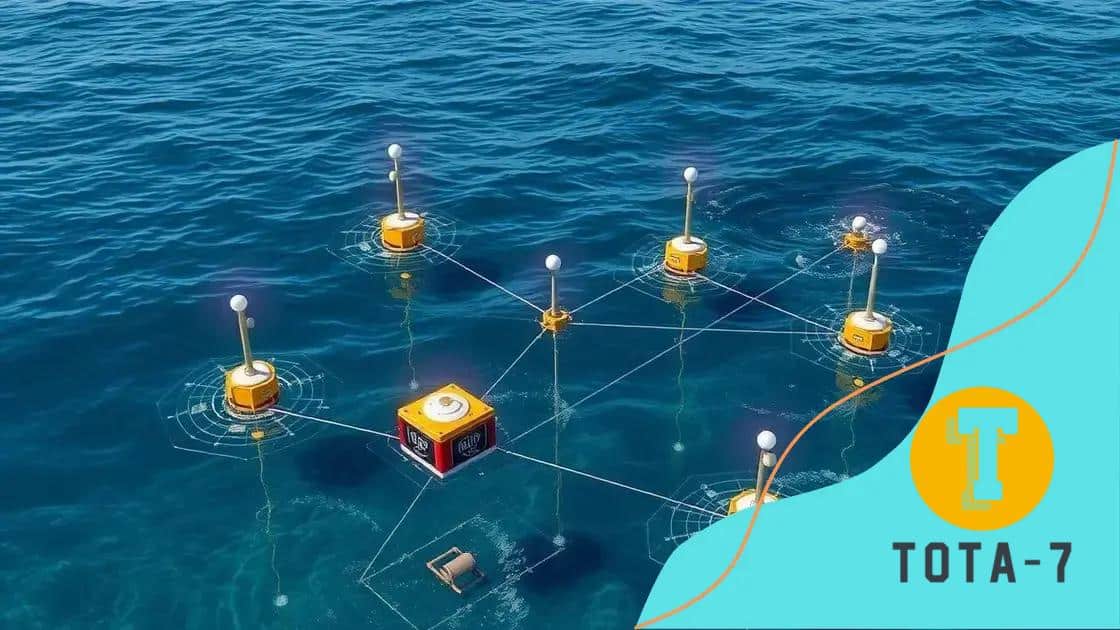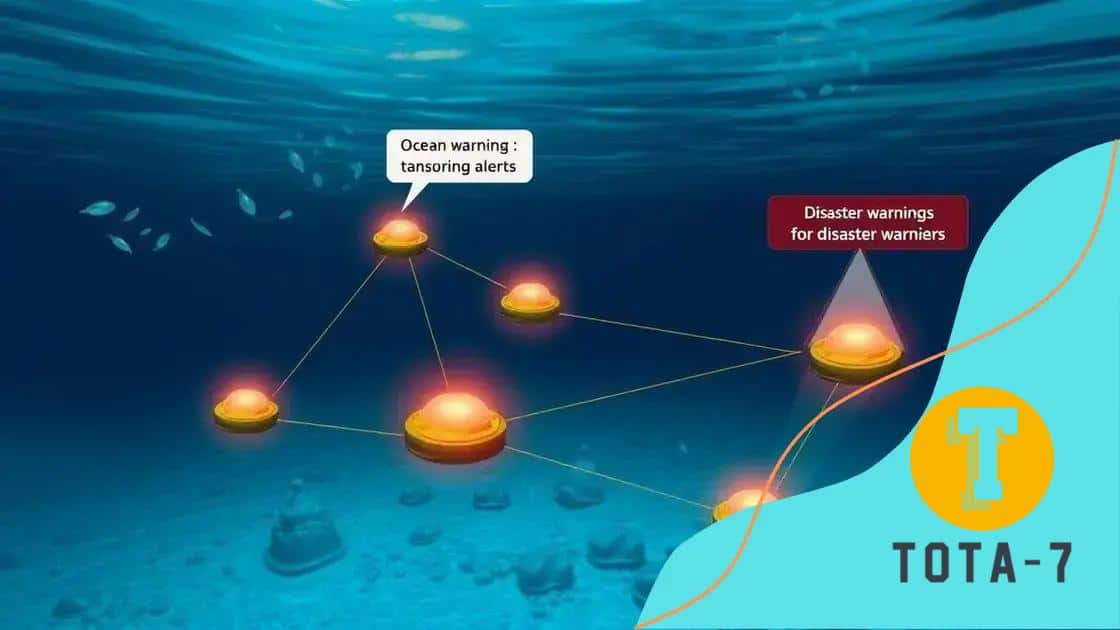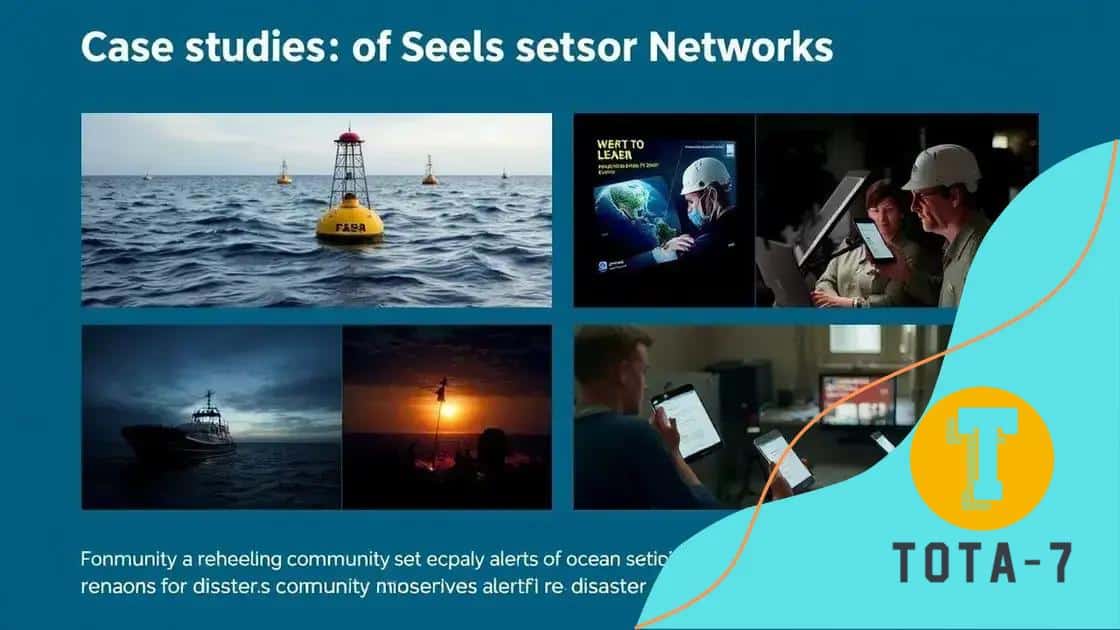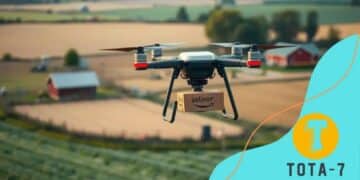Ocean sensor networks deployed for early disaster alerts

Ocean sensor networks deployed for early disaster alerts utilize real-time data to predict and manage disasters, enhancing community resilience and allowing for timely evacuation to save lives.
Ocean sensor networks deployed for early disaster alerts are becoming crucial in safeguarding lives and property. Have you ever wondered how technology can predict disasters before they strike? Join us as we navigate through this essential topic.
Understanding ocean sensor networks
Understanding ocean sensor networks is essential for grasping how technology can aid in disaster management. These networks are composed of various sensors that monitor different oceanic conditions. They collect real-time data, which is crucial for early-warning systems designed to prevent disasters.
In these networks, different types of sensors play unique roles. They can measure temperature, salinity, and wave heights, providing valuable insights into changing ocean conditions. This data is transmitted to researchers and authorities, who analyze it to predict potential disasters.
Key Components of Ocean Sensor Networks
Several components are vital for the effective functioning of ocean sensor networks:
- Buoys equipped with sensors
- Autonomous underwater vehicles (AUVs)
- Satelite-based monitoring systems
- Data collection platforms
These components work collaboratively, enabling comprehensive monitoring of the ocean. Data gathered can indicate changes in weather patterns, prompting timely warnings.
Moreover, ocean sensor networks are increasingly integrated with advanced analytics and machine learning tools. This integration allows for the quick processing of large data sets. By predicting anomalies, these networks can alert authorities to impending disasters swiftly.
Benefits of Monitoring the Ocean
Understanding the ocean’s behavior provides significant advantages:
- Improved disaster response times
- Better resource allocation during emergencies
- Enhanced scientific research on climate change
- Strengthened coastal community resilience
Ultimately, grasping how these systems operate can help us use them more effectively. While the technology continues to evolve, the core purpose remains the same: protecting lives by providing critical information during emergencies.
How they function in disaster alerts

Understanding how ocean sensor networks function in disaster alerts is vital for effective emergency management. These networks utilize a variety of technologies to gather and analyze ocean data.
The core of their operation lies in data collection from various sensors deployed in the ocean. These sensors measure important parameters such as temperature, pressure, and wave heights. By continuously monitoring these conditions, they provide real-time information that can indicate potential disasters.
Data Transmission Mechanisms
Once data is collected, it must be transmitted efficiently:
- Wireless communication systems send data from buoys to terrestrial stations.
- Satellite links can relay information from remote locations.
- Underwater cables also play a role in data transport.
Such transmission methods ensure that timely data reaches decision-makers who can act quickly to mitigate risks.
Moreover, the integration of sensors with advanced software means that anomalies can be detected swiftly. For instance, sudden changes in water temperature might signal an approaching storm. This capacity for rapid analysis helps authorities prepare and inform communities at risk.
Early Warning Systems
A key feature of these networks is their use in early warning systems:
- Alerts trigger when data indicates hazardous conditions.
- Automated notifications can be sent to relevant agencies.
- Public alert systems provide crucial information to citizens.
Such systems can reduce response times and save lives. By utilizing ocean sensor networks, communities can be better prepared for the unexpected.
Benefits of early alerts through sensors
The benefits of early alerts through sensors are numerous and significant in disaster management. By using ocean sensor networks, we can gain critical insights into environmental changes that may signal an impending disaster.
One major advantage is the ability to save lives. Early alerts allow communities to evacuate and prepare for dangerous situations in advance. This proactive approach reduces panic and leads to safer outcomes.
Key Advantages of Early Alerts
Consider some key benefits:
- Quick response times from emergency services.
- Reduced economic impact by minimizing damage.
- Customization of alerts based on specific locations.
- Informed decision-making for civilians and authorities.
By leveraging real-time data, authorities can pinpoint areas at risk. This level of precision can lead to tailored evacuation plans that are more efficient and effective. The use of technology helps in disseminating information rapidly, ensuring that everyone receives timely alerts.
Moreover, a well-implemented alert system promotes community resilience. When people understand the signs of an imminent disaster, they are more likely to take action. Increased awareness through education and preparedness initiatives also plays a crucial role.
Long-Term Impacts
In the long run, the benefits of early sensor alerts extend beyond immediate responses. They contribute to improved infrastructure planning and development. Authorities can invest in better resources and implement preventative measures based on data trends.
Additionally, these systems can enhance scientific research on climate change and environmental conditions. By collecting and analyzing data, scientists gain a better understanding of patterns and signals. This knowledge can inform future policy and community planning.
Case studies: Success stories

Examining case studies of successful ocean sensor networks reveals their impact in disaster prevention. These real-life examples illustrate how timely data can save lives and protect communities.
One notable case occurred in Japan, where ocean sensor networks helped predict the 2011 tsunami. Sensors detected changes in wave patterns and communicated this vital information to local authorities. This advance notice allowed residents to evacuate before the tsunami hit, significantly reducing the potential loss of life.
Global Examples of Success
Several countries have also implemented effective warning systems:
- The United States has a NOAA network that tracks hurricanes, providing early alerts.
- In Indonesia, a comprehensive sensor system aids in tsunami detection, saving countless lives.
- Australia’s Early Warning System for tropical cyclones allows for proactive measures.
These examples showcase how the integration of sensor technologies can lead to quicker responses and better preparedness. In many instances, communities have been able to activate emergency protocols based on real-time data.
Furthermore, enhanced communication during these incidents played a critical role. By sharing information across multiple platforms, more people received alerts in a timely manner. Studies show that this kind of widespread collaboration improves overall response effectiveness.
Long-Term Success of Sensor Networks
The success of these case studies shows the importance of continual investment in ocean sensor networks. These systems not only protect lives but also encourage innovation in disaster management strategies.
As these technologies evolve, we can expect even greater successes in future crises.
Future of ocean sensor technology
The future of ocean sensor technology looks promising as advancements continue to enhance our understanding of the ocean. Innovations in this field aim to improve the accuracy and reliability of data collection, which is crucial for disaster preparedness.
New materials and designs are being explored to make sensors more durable and effective. This includes using advanced composites that can withstand harsh ocean environments. As technology progresses, we might see sensors that are smaller, more energy-efficient, and capable of gathering more data.
Emerging Technologies
Several emerging technologies are transforming how we monitor ocean conditions:
- Autonomous underwater systems that operate without human intervention, gathering vital data continuously.
- Real-time data analytics powered by artificial intelligence, enabling quicker interpretation of complex datasets.
- Advanced satellite systems that provide a global view of ocean health and conditions.
- Enhanced communication systems that improve data sharing across agencies and communities.
Each of these technologies brings unique advantages. Autonomous systems can cover vast areas, while AI analytics allows for faster decision-making based on the information collected.
Moreover, the integration of Internet of Things (IoT) technology into sensor networks can transform data sharing. With IoT, individual sensors can communicate with each other and relay information to a centralized system. This capability can enhance responsiveness to environmental changes in real time.
Sustainability and Future Challenges
Looking ahead, sustainability will remain a primary focus. As we develop new technology, it is essential to ensure that it aligns with environmental conservation efforts. This balance will help protect marine ecosystems while improving our preparedness.
In summary, the ongoing advancements in ocean sensor technology will likely lead to more effective disaster management strategies. As we face increasing climate challenges, this technology will be critical in keeping communities safe.
FAQ – Frequently Asked Questions about Ocean Sensor Networks
How do ocean sensor networks help in disaster management?
Ocean sensor networks provide real-time data that can signal imminent disasters, allowing for quick responses and life-saving alerts.
What types of data do ocean sensors collect?
They collect various types of data, including temperature, salinity, wave height, and other oceanic conditions that help in disaster prediction.
Can ocean sensor technology improve community resilience?
Yes, by providing timely information, communities can prepare better for disasters, reducing panic and promoting safety.
What is the future of ocean sensor technology?
The future includes advancements in AI and IoT integration, leading to smarter, more effective monitoring and faster disaster response.





